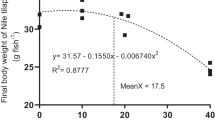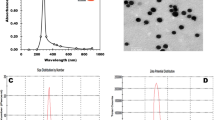Abstract
To determine the relationship between dietary selenium (Se) deficiency or excess and liver hydrogen peroxide (H2O2) metabolism in chickens, 1-day-old chickens received insufficient Se (0.028 mg Se per kg of diet) or excess Se (3.0 or 5.0 mg Se per kg of diet) in their diets for 8 weeks. Body and liver weight changes, alanine aminotransferase (ALT) and aspartate aminotransferase (AST) activities, H2O2 content, and activities and mRNA levels of enzymes associated with H2O2 metabolism (catalase (CAT) and superoxide dismutase (SOD) 1–3) were determined in the liver. This study showed that Se deficiency or excess Se intake elicited relative severe changes. Se deficiency decreased growth, while Se excess promoted growth in chickens. Both diets vastly altered the liver function, but no obvious histopathological changes were observed in the liver. Se deficiency significantly lowered SOD and CAT activities, and the H2O2 content in the liver and serum increased. Se excess (3.0 mg/kg) decreased SOD and CAT activities with changes in their mRNA levels, and the H2O2 content increased. The larger Se excess (5.0 mg/kg) showed more serious effects but was not fatal. These results indicated that the H2O2 metabolism played a destructive role in the changes in bird liver function induced by Se deficiency or excess.


Similar content being viewed by others
References
Li JL, Gao R, Li S, Wang JT, Tang ZX, Xu SW (2010) Testicular toxicity induced by dietary cadmium in cocks and ameliorative effect by selenium. Biometals 23:695–705
Forootanfar H, Adeli-Sardou M, Nikkhoo M, Mehrabani M, Amir-Heidari B, Shahverdi AR, Shakibaie M (2014) Antioxidant and cytotoxic effect of biologically synthesized selenium nanoparticles in comparison to selenium dioxide. J Trace Elem Med Biol 28:75–79
Briens M, Mercier Y, Rouffineau F, Vacchina V, Geraert PA (2013) Comparative study of a new organic selenium source v. seleno-yeast and mineral selenium sources on muscle selenium enrichment and selenium digestibility in broiler chickens. Br J Nutr 11:1–8
Wang Y, Zhan X, Yuan D, Zhang X, Wu R (2011) Influence of dietary selenomethionine supplementation on performance and selenium status of broiler breeders and their subsequent progeny. Biol Trace Elem Res 143:1497–1507
Brennan KM, Crowdus CA, Cantor AH, Pescatore AJ, Barger JL, Horgan K, Xiao R, Power RF, Dawson KA (2011) Effects of organic and inorganic dietary selenium supplementation on gene expression profiles in oviduct tissue from broiler-breeder hens. Anim Reprod Sci 125:180–188
Li JL, Li HX, Gao XJ, Zhang JL, Li S, Xu SW, Tang ZX (2012) Priority in selenium homeostasis involves regulation of SepSecS transcription in the chicken brain. PLoS One 7:e35761
Paton ND, Cantor AH, Pescatore AJ, Ford MJ, Smith CA (2002) The effect of dietary selenium source and level on the uptake of selenium by developing chick embryos. Poult Sci 8:1548–1554
Ozkan S, Malayoğlu HB, Yalçin S, Karadas F, Koçtürk S, Cabuk M, Oktay G, Ozdemir S, Ozdemir E, Ergül M (2007) Dietary vitamin E (alpha-tocopherol acetate) and selenium supplementation from different sources: performance, ascites-related variables and antioxidant status in broilers reared at low and optimum temperatures. Br Poult Sci 48:580–593
Yoon I, Werner TM, Butler JM (2007) Effect of source and concentration of selenium on growth performance and selenium retention in broiler chickens. Poult Sci 86:727–730
Sun B, Wang R, Li J, Jiang Z, Xu S (2011) Dietary selenium affects selenoprotein W gene expression in the liver of chicken. Biol Trace Elem Res 143:1516–1523
Hartikainen H (2005) Biogeochemistry of selenium and its impact on food chain quality and human health. J Trace Elem Med Biol 18:309–318
Peng X, Cui H, Deng J, Zuo Z, Lai W (2011) Histological lesion of spleen and inhibition of splenocyte proliferation in broilers fed on diets excess in selenium. Biol Trace Elem Res 140:66–72
Zwolak I, Zaporowska H (2012) Selenium interactions and toxicity: a review. Selenium interactions and toxicity. Cell Biol Toxicol 28:31–46
Wang ZG, Pan XJ, Peng ZQ, Zhao RQ, Zhou GH (2009) Methionine and selenium yeast supplementation of the maternal diets affects color, water-holding capacity, and oxidative stability of their male offspring meat at the early stage. Poult Sci 88:1096–1101
Mehdi Y, Hornick JL, Istasse L, Dufrasne I (2013) Selenium in the environment, metabolism and involvement in body functions. Molecules 18:3292–3311
Peng X, Cui H, He Y, Cui W, Fang J, Zuo Z, Deng J, Pan K, Zhou Y, Lai W (2012) Excess dietary sodium selenite alters apoptotic population and oxidative stress markers of spleens in broilers. Biol Trace Elem Res 145(1):47–51
Raines AM, Sunde RA (2011) Selenium toxicity but not deficient or super-nutritional selenium status vastly alters the transcriptome in rodents. BMC Genomics 12:26
Xu SW, Yao HD, Zhang J, Zhang ZW, Wang JT, Zhang JL, Jiang ZH (2013) The oxidative damage and disbalance of calcium homeostasis in brain of chicken induced by selenium deficiency. Biol Trace Elem Res 151:225–233
Spallholz JE, Hoffman DJ (2002) Selenium toxicity: cause and effects in aquatic birds. Aquat Toxicol 57:27–37
Hasegawa T, Mihara M, Nakamuro K, Sayato Y (1996) Mechanisms of selenium methylation and toxicity in mice treated with selenocystine. Arch Toxicol 71:31–38
Mousa YJ, Mohammad FK (2012) Effects of hydrogen peroxide on diazepam and xylazine sedation in chicks. Interdiscip Toxicol 5:179–183
Zhang ZW, Wang QH, Zhang JL, Li S, Wang XL, Xu SW (2012) Effects of oxidative stress on immunosuppression induced by selenium deficiency in chickens. Biol Trace Elem Res 149:352–361
Orct T, Blanusa M, Lazarus M, Varnai VM, Kostial K (2006) Comparison of organic and inorganic mercury distribution in suckling rat. J Appl Toxicol 26:536–539
Saad MB, Gertner LR, Bona TD, Santin E (2009) Selenium influence in the poultry immune response–review. Recent Pat Food Nutr Agric 1:243–247
Valko M, Leibfritz D, Moncol J, Cronin MT, Mazur M, Telser J (2007) Free radicals and antioxidants in normal physiological functions and human disease. Int J Biochem Cell Biol 39:44–84
Nazıroğlu M (2012) Molecular role of catalase on oxidative stress-induced Ca(2+) signaling and TRP cation channel activation in nervous system. J Recept Signal Transduct 32(3):134–141
Matsui H, Oyama TM, Okano Y, Hashimoto E, Kawanai T, Oyama Y (2010) Low micromolar zinc exerts cytotoxic action under H2O2-induced oxidative stress: excessive increase in intracellular Zn2+ concentration. Toxicology 276:27–32
Garberg P, Högberg J (1992) Studies on Se incorporation in selenoproteins effects of peroxisome proliferators and hydrogen peroxide generating system. Chem Biol Interact 81:291–306
Hostetler CE, Kincaid RL (2004) Maternal selenium deficiency increases hydrogen peroxide and total lipid peroxides in porcine fetal liver. Biol Trace Elem Res 97:43–56
Demelash A, Karlsson JO, Nilsson M, Björkman U (2004) Selenium has a protective role in caspase-3-dependent apoptosis induced by H2O2 in primary cultured pig thyrocytes. Eur J Endocrinol 150:841–849
Li D, Wang W, Shan YJ et al (2012) Synergy between sulforaphane and selenium in the up-regulation of thioredoxin reductase and protection against hydrogen peroxide-induced cell death in human hepatocytes. Food Chem 13:300–307
Yan H, Harding JJ (1997) Glycation-induced inactivation and loss of antigenicity of catalase and superoxide dismutase. Biochem J 328:599–605
Hassanin KM, El-Kawi SH, Hashem KS (2013) The prospective protective effect of selenium nanoparticles against chromium-induced oxidative and cellular damage in rat thyroid. Int J Nanomedicine 8:1713–1720
Zoidis E, Pappas AC, Georgiou CA, Komaitis E, Feggeros K (2010) Selenium affects the expression of GPx4 and catalase in the liver of chicken. Comp Biochem Physiol B Biochem Mol Biol 155:294–300
Messaoudi I, Hammouda F, El Heni J, Baati T, Saïd K, Kerkeni A (2010) Reversal of cadmium-induced oxidative stress in rat erythrocytes by selenium, zinc or their combination. Exp Toxicol Pathol 62:81–288
Bondy SC (1992) Ethanol toxicity and oxidative stress. Toxicol Lett 63:231–241
Fang KM, Cheng FC, Huang YL, Chung SY, Jian ZY, Lin MC (2013) Trace element, antioxidant activity, and lipid peroxidation levels in brain cortex of gerbils after cerebral ischemic injury. Biol Trace Elem Res 152:66–74
Li Y, Huang TT, Carlson EJ, Melov S, Ursell PC, Olson JL, Noble LJ, Yoshimura MP, Berger C, Chan PH, Wallace DC, Epstein CJ (1995) Dilated cardiomyopathy and neonatal lethality in mutant mice lacking manganese superoxide dismutase. Nat Genet 11:376–381
Nazıroğlu M, Yıldız K, Tamtürk B, Erturan İ, Flores-Arce M (2012) Selenium and psoriasis. Biol Trace Elem Res 150(1–3):3–9
Acknowledgments
This study was supported by the Program for New Century Excellent Talents in University (grant no. NECT-1207-02), the Program for New Century Excellent Talents in Heilongjiang Provincial University (grant no. 1252-NCET-009), and the Doctor Initial Funding of Northeast Agricultural University (grant no. 2012RBC52). We also acknowledge the valuable help provided by all involved workers.
Author information
Authors and Affiliations
Corresponding author
Additional information
Jing-Xiu Xu and Chang-Yu Cao contributed equally to this work.
Rights and permissions
About this article
Cite this article
Xu, JX., Cao, CY., Sun, YC. et al. Effects on Liver Hydrogen Peroxide Metabolism Induced by Dietary Selenium Deficiency or Excess in Chickens. Biol Trace Elem Res 159, 174–182 (2014). https://doi.org/10.1007/s12011-014-0002-z
Received:
Accepted:
Published:
Issue Date:
DOI: https://doi.org/10.1007/s12011-014-0002-z




